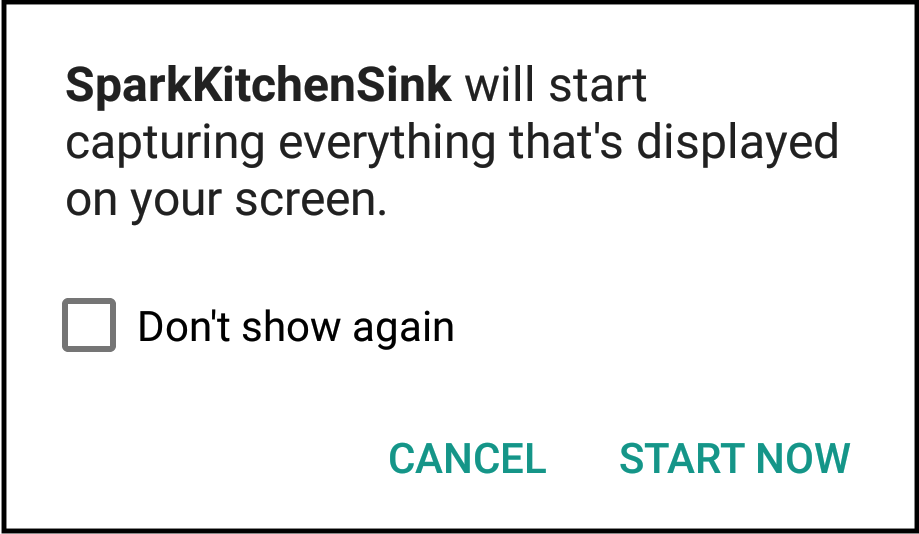This article guides your through implementing screen sharing in your own Android application.
anchorStart Screen Sharing
anchorBefore continuing, ensure that the call is in a CONNECTED status and that you are not already sharing your screen in this call, otherwise, the callback throws an error.
To start sharing your screen:
activeCall.startSharing(r -> Ln.d("startSharing result: " + r));
When initiating screen sharing for the first time, Android displays an alert dialog warning the user that the entire screen will be captured. Checking Don't show again prevents this dialog from appearing in the future:

anchorStop Screen Sharing
anchorThe SendingSharingEvent triggers through the CallObserver.onMediaChanged() callback after successfully starting or stopping screen sharing. Use the isSending() method to check the sharing status:
activeCall.stopSharing(r -> Ln.d("stopSharing result: " + r));
anchorCheck the Status of Screen Sharing
anchorTo check if screen sharing is active:
boolean isSharing = activeCall.isSendingSharing();
anchorSet the Screen Share View
anchorTo view screen or content shared by a remote participant, create a MediaOption with the audioVideoShare function for the dial or answer method:
MediaOption option = MediaOption. audioVideoSharing(new Pair<>(localView, remoteView),shareView);
webex.phone().dial("coworker@acm.com", option, (result) -> {
if (result.isSuccessful()) {
call = result.getData();
call.setObserver(callObserver);
}
//...
});
You can also provide a view only at the point when the other party starts sharing their screen:
MediaOption option = MediaOption. audioVideoSharing(new Pair<>(localView, remoteView),null);
webex.phone().dial("coworker@acm.com", option, (result) -> {
if (result.isSuccessful()) {
call = result.getData();
call.setObserver(callObserver);
}
//...
});
@Override
public void onMediaChanged(MediaChangedEvent mediaChangedEvent) {
if (mediaChangedEvent instanceof RemoteSendingSharingEvent) {
if (((RemoteSendingSharingEvent) mediaChangedEvent).isSending()) {
mediaChangedEvent.getCall().setSharingRenderView(shareView);
} else if (!((RemoteSendingSharingEvent) mediaChangedEvent).isSending()) {
mediaChangedEvent.getCall().setSharingRenderView(null);
}
}
}
anchorScreen Share Optimization
anchorScreen Share Optimization methods are available to enhance the experience of sharing video and text. These API changes are available from version 3.9.0 onwards.
Optimization API Examples
The following are examples of how to use the Screen Share Optimization APIs:
Screen Sharing on Android devices targeting API 28 or earlier:
call.startSharing(CompletionHandler { result ->
if (result.isSuccessful) {
// startSharing successful
} else {
// startSharing failed
}
}, shareConfig = ShareConfig((Call.ShareOptimizeType.AutoDetection, false)))
The shareConfig parameter is optional. If not set, the default optimization with a maximum of 3 fps will be used. The shareConfig parameter is available from version 3.9.0 onwards.
Screen Sharing on Android devices targeting API 29 or later:
call.startSharing(notification = buildScreenShareForegroundServiceNotification(), notificationId = 0xabc61. CompletionHandler { result ->
if (result.isSuccessful) {
// startSharing successful
} else {
// startSharing failed
}
}, shareConfig = ShareConfig((Call.ShareOptimizeType.AutoDetection, false)))
private fun buildScreenShareForegroundServiceNotification(): Notification {
val channelId =
if (Build.VERSION.SDK_INT >= Build.VERSION_CODES.O) {
createNotificationChannel("screen_share_service_v3_sdk", "Background Screen Share Service v3 SDK")
} else { "" }
val notificationBuilder =
NotificationCompat.Builder(requireContext(), channelId)
.setSmallIcon(R.drawable.app_notification_icon)
.setContentTitle(getString("ScreenShare"))
.setContentText(getString("You are starting screenshare"))
.setPriority(NotificationCompat.PRIORITY_MAX)
.setTicker(getString(contentId))
.setDefaults(Notification.DEFAULT_SOUND)
return notificationBuilder.build()
}
The shareConfig parameter is optional. If not provided, the default optimization is used, and audio is not shared. This parameter has been available since version 3.9.0.
To retrieve the current sharing configuration for an active call, use the call.getShareConfig() API.
var sharingConfig = call.getShareConfig()
anchorSet ShareConfig
anchorTo set the share configuration, use one of the following options:
// Default setting: no special optimization, max 3 FPS.
var shareConfig = ShareConfig(Call.ShareOptimizeType.Default, false)
// Auto-detects sharing type, max 5 FPS.
var shareConfig = ShareConfig(Call.ShareOptimizeType.AutoDetection, false)
// Optimizes screen sharing for video/motion, max 30 FPS.
var shareConfig = ShareConfig(Call.ShareOptimizeType.OptimizeVideo, false)
// Optimizes video/motion sharing, max 30 FPS.
var shareConfig = ShareConfig(Call.ShareOptimizeType.OptimizeVideo, true)
// Optimizes text/image sharing, max 5 FPS.
var shareConfig = ShareConfig(Call.ShareOptimizeType.OptimizeText, false)
anchorShareMaxCaptureFPS
anchorThe ShareMaxCaptureFPS method in AdvancedSetting.kt allows for setting the maximum fps during screen sharing. However, the Screenshare Optimization settings will override the ShareMaxCaptureFPS setting.
webex.phone.setAdvancedSetting(AdvancedSetting.ShareMaxCaptureFPS(fps) as AdvancedSetting<*>)
Here are some scenarios showing the interaction between ShareMaxCaptureFPS and screenshare optimization from version 3.9.0:
- Set
ShareMaxCaptureFPS to 10 and OptimizeText in ShareConfig to limit the FPS to 5. - Set
ShareMaxCaptureFPS to 3 and OptimizeText in ShareConfig to limit the FPS to 5. - Set
ShareMaxCaptureFPS to 10 and OptimizeVideo in ShareConfig to achieve a maximum FPS of 30. - Set
ShareMaxCaptureFPS to 7 without using shareConfig to achieve a maximum FPS of 7. - Set
ShareMaxCaptureFPS to 30 without using shareConfig to achieve a maximum FPS of 30. - Do not set
ShareMaxCaptureFPS or set it to 0 without using shareConfig to limit the FPS to 5.
